Blog
Understanding journalism’s role in media brand equity
Explore how journalism shapes trust, audience engagement, and media influence in Australia and New Zealand.
This week, we talk to Stella Muller, the Chief of Enlightenment and Creative Director of Bright Sunday about communicating with diverse audiences. Stella shares a case study on how pacific media agencies in New Zealand worked together to get COVID-19 messaging out in nine different languages to reach New Zealand Pacific audiences.
Isentia’s Insights Director, Ngaire Crawford also shares some of the trends and conversations we’re seeing across social and traditional media, and the role of simple, clear messaging in crisis response.
4:22 – Media narratives have shifted to a global social change movement. The mainstream media is talking about:
5:12 – The social media narrative is more focused around the Black Lives Matter movement and has opened a dialogue about white privilege and police targeting across the world. In the US especially, brands are very clearly being called on to have a view and make that known. Silence is viewed as complicity.
6:11 – On Google Trends, people are searching for:
6:55 – For communicators, be clear in what you say and what you stand for.
8:40 – Some things to look out for in the media:
Nationalist tension vs social change.
10:26 – In March when New Zealand was about to go into lock down, communications were being prepared for the Prime Minister, Jacinda Ardern to communicate to english speaking audiences across mainstream channels. There was a gap as some New Zealand Pacific audiences do not speak english. We needed a solution.
My team spent days translating level 3 and level 4 messages into nine different pacific languages to ensure the pacific community received the correct messaging about COVID-19 and the government’s response.
12:37 – Before communicating the various levels of messaging, there were many clinical messages about washing hands and social distancing, and although these were being translated to our pacific audiences, there was no context around the message. The pacific community was confused for the sudden need to buy toilet paper and the increased need to wash or sanitise their hands.
13:30 – Our elderly, Pacific and Maori communities were most at risk to contract COVID-19 so we needed to ensure they understood the situation. After pitching our idea to the Ministry of Health and Ministry for Pacific Peoples, we had 24 hours to create and record our messaging in the studio, ready to be released after the Prime Minister made the Level 4 alert announcements.

14:50 – For 6 weeks, we broadcast weekly 15 minute bulletins in each of the nine pacific languages. They were distributed across social media, New Zealand radio and mainstream television network TVNZ. Historically, Pacific languages are not televised on mainstream television, so it was quite amazing to see.

15:40 – We were able to deliver the essential information to our leaders and elders in a timely manner so they could then inform their communities. It’s impact also meant we could debunk myths that were circulating around the Pacific community and be the source of truth.
Compliance was a big part of COVID-19 and for our leaders and elders to communicate with confidence, they needed to have access to have the facts direct from the Government.
17:46 – At a time when everything was being categorised as essential or non-essential, it proved why communications are an essential service. Any content that is created or translated during a time like COVID-19, is premium content. To have the ability to cut through to audiences is really impactful.
18:35 – Of the 1,154 cases of COVID-19 in New Zealand, Pacific people made up 5% of those cases and with zero deaths, we feel honoured to have been involved in the communications process for Pacific community.
If you would like to view other Webinar Isentia Conversations: Communicating through Change:
Isentia Conversations: with Katherine Newton at RU OK?
Isentia Conversations: with Bec Brown at The Comms Department
Isentia Conversations: with Rochelle Courtenay at Share the Dignity
Isentia Conversations: with Rachel Clements at Centre for Corporate Health
Isentia Conversations: with Helen McMurdo at MTV
Isentia Conversations: with Daniel Flynn at Thank You
Isentia Conversations: with Campbell Fuller at Insurance Council of Australia
Loren is an experienced marketing professional who translates data and insights using Isentia solutions into trends and research, bringing clients closer to the benefits of audience intelligence. Loren thrives on introducing the groundbreaking ways in which data and insights can help a brand or organisation, enabling them to exceed their strategic objectives and goals.
Explore how journalism shapes trust, audience engagement, and media influence in Australia and New Zealand.
Discover what drives news stories to travel, spread, and shape brand perception.
Get in touch or request a demo.